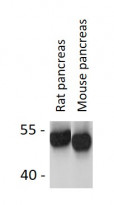ARG59425
anti-AZIN2 antibody
anti-AZIN2 antibody for Western blot and Mouse,Rat
Overview
| Product Description | Rabbit Polyclonal antibody recognizes AZIN2 |
|---|---|
| Tested Reactivity | Ms, Rat |
| Tested Application | WB |
| Host | Rabbit |
| Clonality | Polyclonal |
| Isotype | IgG |
| Target Name | AZIN2 |
| Antigen Species | Human |
| Immunogen | Recombinant fusion protein corresponding to aa. 1-360 of Human AZIN2 (NP_443724.1). |
| Conjugation | Un-conjugated |
| Alternate Names | ornithine decarboxylase paralog; AzI2; ODC1L; ODC-like protein; ARGDC; AZI2; Arginine decarboxylase; ADC; Ornithine decarboxylase-like protein; AZIB1; ODC-p; ODCp; Antizyme inhibitor 2 |
Application Instructions
| Application Suggestion |
|
||||
|---|---|---|---|---|---|
| Application Note | * The dilutions indicate recommended starting dilutions and the optimal dilutions or concentrations should be determined by the scientist. | ||||
| Positive Control | Rat pancreas and Mouse pancreas | ||||
| Observed Size | 50 kDa |
Properties
| Form | Liquid |
|---|---|
| Purification | Affinity purified. |
| Buffer | PBS (pH 7.3), 0.02% Sodium azide and 50% Glycerol. |
| Preservative | 0.02% Sodium azide |
| Stabilizer | 50% Glycerol |
| Storage Instruction | For continuous use, store undiluted antibody at 2-8°C for up to a week. For long-term storage, aliquot and store at -20°C. Storage in frost free freezers is not recommended. Avoid repeated freeze/thaw cycles. Suggest spin the vial prior to opening. The antibody solution should be gently mixed before use. |
| Note | For laboratory research only, not for drug, diagnostic or other use. |
Bioinformation
| Database Links | |
|---|---|
| Gene Symbol | AZIN2 |
| Gene Full Name | antizyme inhibitor 2 |
| Background | The protein encoded by this gene belongs to the antizyme inhibitor family, which plays a role in cell growth and proliferation by maintaining polyamine homeostasis within the cell. Antizyme inhibitors are homologs of ornithine decarboxylase (ODC, the key enzyme in polyamine biosynthesis) that have lost the ability to decarboxylase ornithine; however, retain the ability to bind to antizymes. Antizymes negatively regulate intracellular polyamine levels by binding to ODC and targeting it for degradation, as well as by inhibiting polyamine uptake. Antizyme inhibitors function as positive regulators of polyamine levels by sequestering antizymes and neutralizing their effect. This gene encodes antizyme inhibitor 2, the second member of this gene family. Like antizyme inhibitor 1, antizyme inhibitor 2 interacts with all 3 antizymes and stimulates ODC activity and polyamine uptake. However, unlike antizyme inhibitor 1, which is ubiquitously expressed and localized in the nucleus and cytoplasm, antizyme inhibitor 2 is predominantly expressed in the brain and testis and localized in the endoplasmic reticulum-golgi intermediate compartment. Recent studies indicate that antizyme inhibitor 2 is also expressed in specific cell types in ovaries, adrenal glands and pancreas, and in mast cells. The exact function of this gene is not known, however, available data suggest its role in cell growth, spermiogenesis, vesicular trafficking and secretion. Accumulation of antizyme inhibitor 2 has also been observed in brains of patients with Alzheimer's disease. There has been confusion in literature and databases over the nomenclature of this gene, stemming from an earlier report that a human cDNA clone (identical to ODCp/AZIN2) had arginine decarboxylase (ADC) activity (PMID:14738999). Subsequent studies in human and mouse showed that antizyme inhibitor 2 was devoid of arginine decarboxylase activity (PMID:19956990). Alternatively spliced transcript variants have been described for this gene. [provided by RefSeq, Sep 2014] |
| Function | Antizyme inhibitor protein that positively regulates ornithine decarboxylase (ODC) activity and polyamine uptake by counteracting the negative effect of antizymes OAZ1, OAZ2 and OAZ3 on ODC1 activity. Inhibits antizyme-dependent ODC1 degradation by binding to antizymes. Releases ODC1 from its inactive complex with antizymes, leading to formation of the catalytically active ODC1. Participates in the morphological integrity of the trans-Golgi network (TGN) and functions as a regulator of intracellular secretory vesicle trafficking. [UniProt] |
| Cellular Localization | Nucleus. Cytoplasm. Cytoplasm, perinuclear region. Membrane. Cytoplasmic vesicle. Endoplasmic reticulum-Golgi intermediate compartment. Golgi apparatus, cis-Golgi network. Golgi apparatus, trans-Golgi network. Cytoplasmic granule. Cell projection, axon. Cell projection, dendrite. Perikaryon. [UniProt] |
| Calculated MW | 50 kDa |
| PTM | Ubiquitinated, leading to its proteosomal degradation; a process that is reduced in presence of antizymes. May also be degraded through the lysosomal degradative pathway in a proteosomal-independent manner. [UniProt] |
Images (1) Click the Picture to Zoom In






